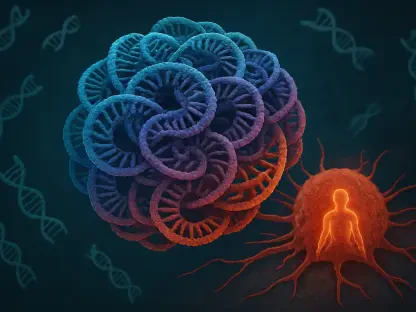In today’s rapidly evolving scientific landscape, especially in microbiology and genetic modification, attention to safety and oversight has never been more crucial. The surge in research focusing on microbial pathogenesis brings a significant promise to understand diseases, but it also raises questions about the security of such innovative endeavors. As scientific research progresses and integrates analysis with emerging methodologies, such as the examination of genetic Sequences of Concern (SoCs), it offers the potential to refine existing oversight mechanisms. This approach aims to build a comprehensive, forward-thinking oversight system that aligns with modern scientific advances, balancing innovation with public safety.
The Landscape of Dual-Use Research
Dual-use research operates within a spectrum where its outcomes could potentially benefit humanity or pose significant biosecurity threats. This duality underscores the need for stringent oversight, especially when the focus is on microbial genetic modifications. In the United States, established frameworks provide guidelines to monitor these research activities, ensuring they do not inadvertently lead to scenarios with catastrophic health implications. At the core of regulatory discussions are policies like Dual-Use Research of Concern (DURC) and the Potential Pandemic Pathogens Care and Oversight (P3CO) framework. These systems are strategically designed to guide researchers in balancing the innovative drive with regulatory safety measures.
Policies Governing Research
Various policies have been articulated over recent years to address challenges posed by dual-use research, such as DURC, initiated with policies in 2012 and 2014, and expanded with the P3CO Framework in 2017. These policies aim to monitor federally funded projects, ensuring scientific experiments involving microbial modification adhere to strict safety standards. Emphasis is placed on preventing the accidental or intentional creation of mutant strains that could immensely threaten human health—an objective pursued through detailed policy outlines. The frameworks are intended to safeguard the delicate equilibrium between scientific exploration and public health security.
Critiques of Current Systems
Despite the arrayed efforts within the current oversight systems, gaps and critiques persist, illuminating potential improvements. DURC policies have been cited for their rigidity, primarily due to dependence on pathogen lists without accommodating emerging threats. This structured approach might inadvertently ignore other high-risk scenarios. Alternatively, the P3CO Framework’s reliance on predicting scientific consequences gives rise to subjective interpretations—a source of significant debate. Such predictions without standardized guidelines can result in diverse interpretations that compromise uniform understanding and action. The critique calls for more adaptable frameworks that can swiftly respond to unrecognized risks.
Historical Precedents and Lessons Learned
Throughout scientific history, insights gleaned from dual-use research often come with miscalculations that have exposed vulnerabilities in research oversight protocols. Notable instances, including gain-of-function projects, act as historical markers from which current oversight strategies can draw lessons. The scientific establishment must navigate these dual-use dilemmas with enhanced vigilance, given their potential consequences. Reflecting on past research errors can inform future approaches by reinforcing the imperative of stringent oversight measures tailored to preempt potentially hazardous outcomes in microbial research.
Gain-of-Function Experiments
Gain-of-function experiments stand as one of the quintessential examples underscoring the fine balance between harnessing scientific insights and safeguarding biosecurity. These experiments reveal pathogenic mechanisms and inform disease intervention strategies yet simultaneously risk augmenting virulence attributes. By learning from past missteps, the scientific community acknowledges the importance of rigorous monitoring methods. The lessons learned serve as a guiding force behind the need to evolve oversight policies to accompany scientific growth, ensuring robust frameworks are in place to mitigate adverse outcomes.
The Murine Interleukin-4 Case
The murine interleukin-4 experiment serves as a poignant example where genetic modifications unintentionally boosted pathogen virulence, highlighting unforeseen consequences. This case accentuates the need for foresight in modifying microbial sequences and the consequent necessity for proactive monitoring practices. It underscores the inherent unpredictability in genetic alterations and the indispensability of anticipatory oversight strategies. By identifying these vulnerabilities, the importance of establishing comprehensive review protocols becomes apparent, setting a precedent for rigorous scrutiny of genetically oriented dual-use research.
Sequences of Concern: The New Frontier
Moving beyond traditional oversight mechanisms, the concept of Sequences of Concern finds its relevance in modern microbial research frameworks. SoCs encompass genetic sequences that, upon modification, could drastically alter a microbe’s pathogenic profile—pointing to oversight centered around genetic rather than pathogen-focused frameworks. This transformative prospect heralds a paradigm shift from pathogen lists to comprehensive genetic makeup considerations, forging pathways for innovative yet secure interpretations of microbial research outcomes.
Defining Sequences of Concern
Sequences of Concern transcend historically acknowledged dangerous microbes. They permeate a vast array of pathogens owing to their potential influence on microbial pathogenesis. Introducing SoCs expands the horizon of oversight, surveilling genetic factors rather than limiting scrutiny to commonly identified high-risk microbes. Controlled vocabularies, such as Functions of Sequences of Concern (FunSoCs), propose a structured model by which these sequences can be categorized to apprehend their related pathogenic impacts. Adopting such vocabularies articulates the varied roles genetic sequences play in influencing virulence, offering new insights into advancing oversight methodologies.
FunSoCs and Pathogenic Activity
Through FunSoCs, sequences are organized based on their contributions to pathogenic mechanisms, including cytotoxicity, immune evasion, and host-pathogen dynamics. This systematic approach to categorization enhances anticipatory measures and highlights infection risks posed by genetic modifications. Recognizing these functionalities empowers researchers to foresee and mitigate threats, foster safer scientific exploration, and bridge existing oversight gaps. With an elucidative framework in place, oversight processes could considerably benefit from more informed, nuanced analyses corresponding to genetic research advancements.
Enhancing Oversight with Annotated SoCs
Annotated SoCs stand to augment current biorisk management practices, serving as an invaluable component in assessing dual-use research proposals. This annotation method may elevate comprehension within oversight bodies, furnishing precise criteria for identifying potentially hazardous research endeavors. The streamlined, scientific rationale provided by annotated sequences could enhance transparency and expeditiously address regulatory gaps persisting in policies.
Annotated SoCs as Indicators
Annotated sequences of concern could function as pivotal indicators requiring focused attention, mainly when experiments potentially augment pathogen functionality. By substantiating oversight with scientific evidence, annotations can clarify decision-making processes and promote regulatory coherence. Integrating these insights into existing protocols not only bridges current methodological gaps but presents a basis for empirically rooted evaluations of microbial modifications, instilling confidence in regulatory actions.
Adapting Policies with Annotations
Implementing annotated SoCs within existing frameworks can enrich pathogen list-based oversight, widening the anticipatory scope. The standardized use of SoCs, as proposed, could garner international consensus, fostering cross-border collaboration and facilitating coherent global practices in dual-use oversight. Aligning international perspectives under a standardized rubric encourages consistent research evaluations, addressing global concerns linked to microbial research and amendments effectively.
Balancing Innovation and Safety
In the current era, marked by swift scientific advancements, particularly in fields like microbiology and genetic modification, the emphasis on safety and regulatory oversight has become immensely vital. The ongoing surge in research targeting microbial pathogenesis is promising in its potential to deepen our understanding of diseases, but it simultaneously brings up critical questions regarding the security and ethical aspects of these innovative efforts. As scientific endeavors continue to evolve, there is a compelling need to integrate modern methodologies. Notably, the evaluation of genetic Sequences of Concern (SoCs) has emerged as a pivotal approach that could enhance current oversight mechanisms. This not only serves to refine processes but also aids in developing a robust, forward-looking regulatory framework. Such a framework is essential to ensure that scientific innovation aligns harmoniously with public safety imperatives. By advancing a regulatory system that is comprehensive and anticipatory, we can effectively balance the dual imperatives of encouraging innovative research and ensuring public health security. This delicate balance is increasingly crucial in an era where scientific breakthroughs rapidly transform societal landscapes, necessitating proactive and thoughtfully designed oversight strategies.









